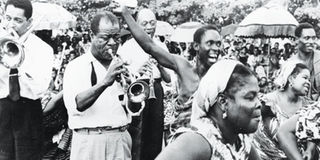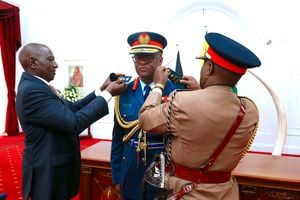‘I always say a note is a note in any language’

American jazz great Louis Armstrong (centre) performs in Accra, Ghana, in his 1960 tour of Africa. He died in 1971 aged 70. PHOTO/ AFP
What you need to know:
- In 1960, the legendary American jazz trumpeter, Louis Armstrong, toured Africa for the second time performing in Accra, Kinshasa, Kampala, Nairobi and Nakuru to standing ovations. In appreciation for the universality of his music, combatants in Congo observed a ceasefire as peals of melody issued from his trumpet to smoothly disappear in the humid skies of Kinshasa
During his famous second tour of Africa 51 years ago, the great jazz trumpeter Louis Armstrong temporarily stopped a civil war in Belgian Congo and attacked the apartheid regime over a planned performance for whites only in South Africa.
The goodwill tour with his All-Stars band took him to the Congo Republic, Ghana, Nigeria and Kenya, where he was given wild receptions. He went to Uganda under the sponsorship of the US Department State’s cultural exchange programme in co-operation with the American National Theatre and Academy, and Pepsi Cola.
Armstrong was given a welcome of tribal dances, tom-tom bands, and a song specially composed in his honour when he arrived for an open concert in Leopoldville on October 28, 1960. He played to more than 40,000 in Accra and Leopoldville. A crowd of about 200 greeted him as he landed from the Brazzaville ferry, escorted by a jeep-load of Ghanaian UN troops.
“Louis actually stopped a war,” Floyd Levin writes in his book, Classic Jazz: A Personal View of the Music and the Musicians.
“At one place, we arrived during a civil uprising. Opposing factions halted their fighting to meet us at the ferry landing. They all had rifles over their shoulders but sat together listening to the concert. After we left, the shooting resumed.”
By any measure Louis Armstrong’s tour of Africa was a huge diplomatic success. More than two million Africans enjoyed the great trumpeter’s music and homespun charm. Photos of him surrounded by throngs of smiling Africans appeared in newspapers around the world.”
There were conflicting reports earlier that year (1960) that Armstrong “Satchmo” had been refused permission to perform in South Africa, and another that he had refused to play to segregated audiences.
According to the Uganda Argus newspaper edition of November 1, 1960, his personal physician, Dr Alexander Schiff said: “We never asked South Africa for a visa so there was no question of our being refused one.”
He added: “We never intended to go there and we signed no contracts. As far as we are concerned, South Africa does not exist.
Maybe one day when they become human beings, we will go there, but not while the present people are in power,” Schiff added.
“We are not afraid to go anywhere,” Armstrong himself said. “Maybe one day when the grievances have been straightened out we will get to South Africa.”
However, Levin gives a different account of the Armstrong – South African relationship:
“In 1960, three years after his aborted trip to the Soviet Union, Armstrong completed a series of African concerts… The All-stars attracted overflow audiences in stadiums that held more than fifty thousand people. The itinerary included several dates in South Africa, but the apartheid regime banned the group at the last minute because Armstrong refused to play to segregated audiences. The South Africans also objected to the group’s racial mixture – the All-Stars included black, white and Hawaiian members,” Levin writes.
In Kampala, Armstrong gave two concerts at Nakivubo War Memorial Stadium. The first was on the night of October 31, 1960, and the second held on November 2, 1960, due to public demand.
“A multi-racial jazz band playing When You’re Smiling greeted the doyen of Dixieland and New Orleans Jazz, Armstrong, when he arrived in Nairobi last night from Entebbe to continue his good-will tour of Africa”, the East African Standard newspaper reported on November 4, 1960.
Satchmo, looking tired after his trip which had taken him to the Congo, Ghana, Nigeria and Uganda, was welcomed by the acting American Consul-General, Mr. W.P. O’Neill, and the Kenya Minister for Broadcasting, Mr Harris. He also shook hands with two Kanu officials in the group, Mr T.J. Mboya and Dr M. Waiyaki.
Satchmo was accompanied by his wife, Lucille. The group included instrumentalists, Barney Bigard (clarinet) and Mort Herbert (bass), William Billy Kyle (piano), Trummy Young (trombone), Danny Barcelona (drums) and vocalist Velma Middleton.
He laughed off a suggestion that he looked tired, but his wife, Lucille confided: “He is. It’s not the work but all the travelling.”
As the band struck up with Blueberry Hill, the famous jazz trumpeter moved up to then airport balcony and beamed when they rendered I can’t give you anything but love and the inevitable Saints.
After the performance, he applauded and growled: “That was swell, boys. Maybe we can get together some time, but right now I need some sleep and food.”
The Kenyan band conducted by Reg Manus, consisted of 16 musicians from the Jambo Boys, The Bata Shoe Shine Boys, The Royal Inniskillings Band, and the Goan Band.
As he left the airport, a group of marching Kanu supporters sang a freedom song and gave Mr Armstrong the uhuru “V” sign. He moved forward to listen and hesitantly waved back, but as the men struggled with police to get closer he took his wife by the arm and murmured: “Let’s get out of here before there’s a fight.”
Armstrong wiped his brow, grinned from ear to ear and told a press conference in Nairobi: “You boys write what you like about me – I don’t mind, just as long as you spell my name right,” the East African Standard reported on November 4, 1960.
Then the man whose name is synonymous with the jazz of the cotton-pickin’ Twenties gave the most hilarious press conference Nairobi has seen for years. He commented on newspaper reports that he was tired when he arrived – “people do get tired, you know, but I’ve had a good sleep.”
He added: “Just ask me about music. Don’t talk about politics because I don’t understand – the words are so big that by the time they’re broken down to my size the joke’s over.”
Armstrong said he and his All-Stars – including Trummy Young and Barney Bigard – were having wonderful concerts everywhere in Africa and were enjoying their trip. “We thought we’d be afraid in the Congo, but it was the easiest of the lot. Man, they had me up on a chair like a king.”
Asked how the African climate was affecting his playing, Satchmo said: “I perspire a little when I blow, but I never faint or anything like that because I’m cool all the time”
Talking about his concerts – Satchmo promised: “You’re going to enjoy them because I always say a note’s a note in any language.”
Satchmo had four shows in Kenya two at the Nairobi City Hall on November 4 and 5 and at the African Stadium in Nairobi on November 5 and the last in Nakuru on November 7.
A tumultuous welcome from a capacity audience greeted Armstrong, generally acknowledged as the greatest of all jazz musicians, when he appeared with his band at Nairobi City Hall on November 4.
Watching his virtuosity in such numbers as When the saints Go Marching, it was hardly credible that it was nearly 40 years since he had done, with “King” Oliver, some of the finest recordings in the history of jazz.
The famous voice, sounding like one of the coarser brands of emery paper, got the session off to a fine start with Sleepy Time Down South and then brilliant ensemble work mixed with enthusiastically applauded solos.
Armstrong showed his instinctive feeling for the music that stems from Africa in Basin Street Blues but the six-man band’s antics soon proved they were giving a comedy show as well as a jazz concert.
Armstrong and his All-Stars received an enthusiastic welcome from hundreds of jazz lovers at a concert at the Nakuru African Stadium November 7 according to the East African Standard on November 9, 1960. The Daily Nation hadn’t been born yet.
Every item roused response as Satchmo and his instrumentalists delighted fans with a repertoire of old favourites which they had previously heard only in canned form, the paper added.
Most popular items were Mack The Knife, High Society and Twelfth Street Rag. Satchmo did not hog the limelight, but gave each of his players, ample chance to show individual paces. The second half failed to recreate the atmosphere of the first.
Armstrong had earlier toured Africa in 1956 and performed with E.T. Mensah of Ghana in Accra before enormous crowds and at Mensah’s own club, the Paramount Night Club.
Armstrong spoke enthusiastically of his second tour of Africa in 1960: “I’ve liked the trip right from the first day” he said. “It’s always been my ambition to tour Africa – being of somewhat African descent!”
‘What happened was that dances were staged in his honour. Thirty thousand people packed an open-air concert and… they carried him into the stadium for his concert on a sedan chair – just like a real king,” Schiff added.
Levin writes that: “The African tour included some of Armstrong’s most inspiring performances and his most poignant interactions with fans. When the All-Stars returned to the United States, Barney Bigard gave me a carton full of mementos.
“When we got off the plane in the Belgian Congo, thousands were waiting for us,” he said. “They lifted Louis on a large canvas throne and carried him through the streets to the stadium shouting, ‘Satchmo!’ ‘Satchmo!’ It was hotter’n hell, and all the concerts were outdoors – but they were always jam-packed.”



